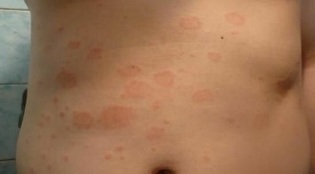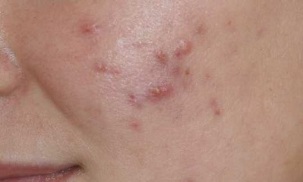
Pictures of psoriasis in the early stages of development can help diagnose the disease.
It is important to understand that the disease can manifest itself in different ways in different people - the degree of intensity, the activity of the spread, the location of the damage and other factors.
The main task is to identify the symptoms and immediately begin treatment of the initial stage of psoriasis.
Features and symptoms of the initial stage
If you know exactly what the initial stage of psoriasis looks like, you can literally start treating the disease. Early-stage symptoms have characteristic symptoms that allow you to treat psoriasis at an early stage before going to the doctor.
Yes, not all people have the opportunity to see a dermatologist immediately in the early stages of the disease. Therefore, treatment at home with simple means is relevant. It can be folk remedies and prescriptions, non-hormonal ointments or non-hormonal medications.
What does psoriasis look like in the early stages? Pay attention to the condition of your skin.
The early signs of early psoriasis are:
- A rash with bright colors and clear edges in different parts of the body. Particularly prone to such rashes are areas of the skin that have recently suffered from burns, cuts or hypothermia. The first symptoms may appear 7-14 days after skin damage;
- Peeling the rash. Occurs in the center of the plates;
- Itching. Psoriatic plaques and papules gradually begin to itch. However, not all psoriasis is itchy, because these symptoms are not universal. It manifests itself in about half of patients.
Initially, the papules in the early stages, ie acne, are very small. Their shape is hemispherical and the surface is smooth and shiny. After a few days, the rash grows and light scales appear on it.
If you cut this scales of the disease and find three characteristic phenomena, then you can accurately determine that you have psoriasis at an early stage.
- Stearin stains. The scales should be easily removed from the surface of the papules, even if you touch them a little in the true sense of the word.
- Movie. The thermal film appears after the scales are removed. The skin underneath is red, thin and moist. The surface of the papule without scales is shiny.
- raw. After shaving the scales, drops of blood appear in place.
Initial symptoms usually last several weeks. It is extremely important to start effective treatment during this period. If you ignore the disease, the papules can grow up to 3-8 centimeters, can coalesce and affect large areas of skin.
Early manifestations of psoriasis
The initial stage of the disease is accompanied by localization in various parts of the body. It is almost impossible to predict exactly where psoriasis occurs. However, you can accurately determine how psoriasis manifests itself in certain parts of the body in the early stages of the disease.

Often suffer in the first stage:
- Elbows;
- Feet;
- Head;
- Nails;
- Hand;
- Face.
How does a pearl manifest itself in the body or in other areas?
- Elbows.Photographs of the initial stage with ulnar psoriasis show that a person is mainly dealing with the plaque form of the disease. The main symptom is a small red rash. Spills are covered with scales fairly quickly. The skin is very rough.
- Feet.As with the elbows, only small rashes appear on the legs, gradually increasing in number and size. Often the first papules occur in the legs or knees. However, in some cases, the lesions affect other surfaces of the legs.
- Title.There are two types of lesions - skin or hairy. The areas behind the ears and head suffer first. Papules on the head are often accompanied by unpleasant itching. The papules themselves are characterized by moisture and cracking.
- Nails.The photo allows you to clearly understand that nail psoriasis in many ways resembles the appearance of fungi. Initially, longitudinal grooves appear or a kind of indentation appears at the edge of the nails. Then the disease spreads to the roots of the nails. Gradually, the nail plate becomes dull and noticeably thicker. As the disease progresses, the nails gradually separate from the finger and peel off. There is nothing pleasant about it, so it is recommended to see a doctor immediately. Will prescribe the appropriate drug for external and internal use.
- Face.Fortunately for many people, especially women, psoriasis is a very rare form of the disease. However, if you come across it by chance, you can identify it by the formation of red papules on the eyelids, lips and nose, near the eyes and eyebrows. Also, psoriasis can appear on the cheeks and looks like thin mesh. Psoriatic neoplasms of the lips, tongue and oral mucosa are extremely rare.
- Hands.If psoriasis affects the hands, the bending parts - the fingers and elbows - are usually the first to suffer. Externally, psoriasis on the hands resembles wounds. There are cases of papules on the surface of the palm. In this course of the disease, psoriasis usually affects the legs.
Psoriasis Treatment Techniques

As soon as you notice the first signs of the disease, you should see a doctor and start getting rid of the disease. The problem for many is that they start treatment late. And the treatment of psoriasis requires a complex aimed at internal and external effects.
The essence of complex treatment is the simultaneous use of several methods:
- Medication.Its essence is to take medication. All are divided into hormonal and non-hormonal. In the initial stages are prescribed only non-hormonal. You should only switch to hormonal medications, antibiotics and other medications if your condition worsens and psoriasis develops rapidly.
- External influences.Here we are talking about the use of ointments, creams and shampoos. Lotions, balms, all kinds of springs and baths prepared according to folk recipes are also used. Ointments are known to be the most effective treatment for psoriasis. In this case, the ointments are both hormonal and non-hormonal. As with medications, use only non-hormonal ointments in the early stages. These are quite effective, but have a number of contraindications and side effects.
- Physiotherapy.The patient may be prescribed ultraviolet radiation, PUVA therapy, electrosleep or other inpatient procedures. Physiotherapy is most effectively treated in sanatoriums and resorts.
- Proper nutrition.It is very important to change your lifestyle if you are prone to the disease due to alcohol, junk food or smoking. With the exception of often harmful products and getting rid of addiction, the person's condition is normalized and psoriasis does not bother for too long. This is a proven fact in practice.
In the early stages of a disease like psoriasis, it can be detected and treated. This is the most beneficial scenario for the patient, because the suppression of psoriasis requires a minimum of effort, time and money.
























